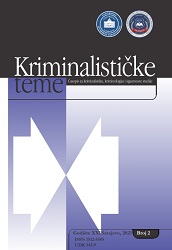Procesi i kriteriji pozicioniranja zatvorenika u internom hijerarhijskom sustavu unutar penalne ustanove tijekom izvršavanja kazne zatvora
Processes and Criteria for Positioning Prisoners in the Internal Hierarchy System within the Penal Institution During the Imprisonment
Author(s): Anita Jandrić Nišević, Helena Gutrung, Joško VukosavSubject(s): Social psychology and group interaction, Criminology, Penology
Published by: Fakultet za kriminalistiku, kriminologiju i sigurnosne studije Univerziteta u Sarajevu
Keywords: hierarchical system; prisoners; social hierarchy; imprisonment;
Summary/Abstract: Bearing in mind the specifics of the functioning and organization of prisons and penitentiaries and the heterogeneity of the population serving prison sentences, the occurrence of the positioning of prisoners within the hierarchical system is expected. The aim of this paper is to provide insight into the processes and criteria for positioning prisoners in the internal hierarchical system while serving a prison sentence, in order to identify potential activities that may affect the security level of the institution and disrupt rehabilitation efforts. A review of the literature found that the following factors have a key influence on the position of prisoners in the internal hierarchical social order: masculinity, type of crime, age and length of stay in the penitentiary institution, as well as behaviors related to adherence / violation of the prison code. The results of the literature analysis point to the fact that at the top of the hierarchy are dominant and masculine prisoners and older, experienced prisoners with longer time of imprisonment. On the other hand, the lowest positions belong to perpetrators of crimes against children and to prisoners in collusion with prison staff. The positioning of prisoners within the social hierarchy is associated with the occurrence of violent behavior, which can negatively affect the relations of prisoners with prison staff and the success and results of their rehabilitation procedures. On the other hand, the potential positive consequences, such as maintaining order or cooperation some prisoners with staff in favor of detecting and resolving internal problems, are not negligible. Adequate familiarity of professionals and staff with the social hierarchy of prisoners, as an almost inseparable part of the prison environment, can be used to create treatment methods to maintain order and security of the penitentiary institution and thus potentially improve rehabilitation outcomes and quality of life of prisoners.
Journal: Kriminalističke teme – Časopis za kriminalistiku, kriminologiju i sigurnosne studije
- Issue Year: XXI/2021
- Issue No: 2
- Page Range: 65-82
- Page Count: 18
- Language: Croatian

